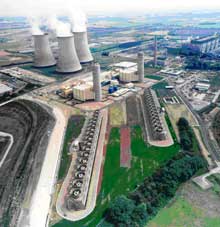
Posted to News on 17th Dec 2007, 22:53
JW Townson gets perfect marks at Didcot power station
James Walker Townson has supplied Comflex double expansion joints with a pantograph control mechanism to replace metallic expansion joints at Didcot power station.

James Walker Townson has successfully completed a challenging turnkey project to produce and install new expansion joints and steelwork at England's Didcot Gas Turbine Power Station while overcoming tight and demanding conditions.
This notable achievement follows a trail of successful work by JWT on their Comflex fabric expansion joints at the power plant, which was constructed in 1995 using four Siemens V94.3 and V93.3a gas turbines, with metallic outlet expansion joints supplied by a German manufacturer, and four Rolls Royce heat recovery steam generators (HRSGs).
Demanding conditions such as temperatures up to 585degC, pressures from +7000 to -5000Pa, base load gas velocity of 125m/s and daily peak cyclic loading led to the metallic bellows starting to crack after a few years. In 2002 Siemens asked JWT to produce temporary fabric expansion joints that would allow continued electricity production with minimum downtime until the next major outage.
The four temporary expansion joints performed perfectly well for over three years and while the new project called for two of them to replaced when the metallic expansion joints underneath them continued to decay, with bellows parts found in the exhaust duct, the other two have now been operating for over four years.
Extreme conditions
JWT replaced two of the existing metallic expansion joints with fabric joints produced to survive the extreme gas and cyclic conditions. The remaining two continue operating with the temporary joints awaiting a decision on the future of the turbines themselves.
The temporary joint mounting flanges had been designed to withstand the cyclic conditions using JWT's stepped configuration against finite element calculations to give over 5000 life cycles. This design flexes to accommodate temperature differences, whereas conventional flanges are stressed and distorted by such differentials and can fail prematurely. As the flanges had operated well within their design life it was decide to leave them in their existing position and use them for the new design.
Although JWT's flexible elements withstand the full gas temperatures, insulation pillows are integral to providing additional thermal protection, among other things, and help extend joint life by ensuring even cooler running. They are made from various layers of insulation to achieve the thermal properties, giving flexibility but with the material staying where pushed and not springing back.
Split pillow design
Cyclic operations are normally a problem for insulation pillows, with every cycle pushing or stretching the material into position, but JWT overcame this by providing a split pillow design. Each half is constructed as an individual pillow.
These pillows move toward each other as the system warms up and touch during operation. The materials are never compressed or stretched, as they operate in their natural relaxed state, which prevents tearing as a result of lateral movement.
Fabric joints must operate under minimal stress to ensure maximum material life, but conventional multi-layered fabric joints only accommodate limited axial and lateral movements. An arch configuration can help but not enough to accommodate Didcot's design conditions. To overcome this problem James Walker Townson provided its Comflex double expansion joint with a pantograph control mechanism.
The principal of this is that each joint is mounted almost vertically, with its outer part set on a central carrying frame and the inner part on the stepped flange. Axial movement is accommodated in each joint by it pivoting at the central frame and is transferred to each joint equally by a set of pantograph control mechanisms. The materials are not compressed as in a conventional joint as they are just pivoting in their natural state.
The project was made more complex as all new steelwork had to be manufactured small enough to be taken into the duct through a man access door and all components had to be assembled and welded together inside the duct. A six-man team met the 28-day project schedule.
Want the latest machine building news straight to your inbox? Become a MachineBuilding member for free today >>


















